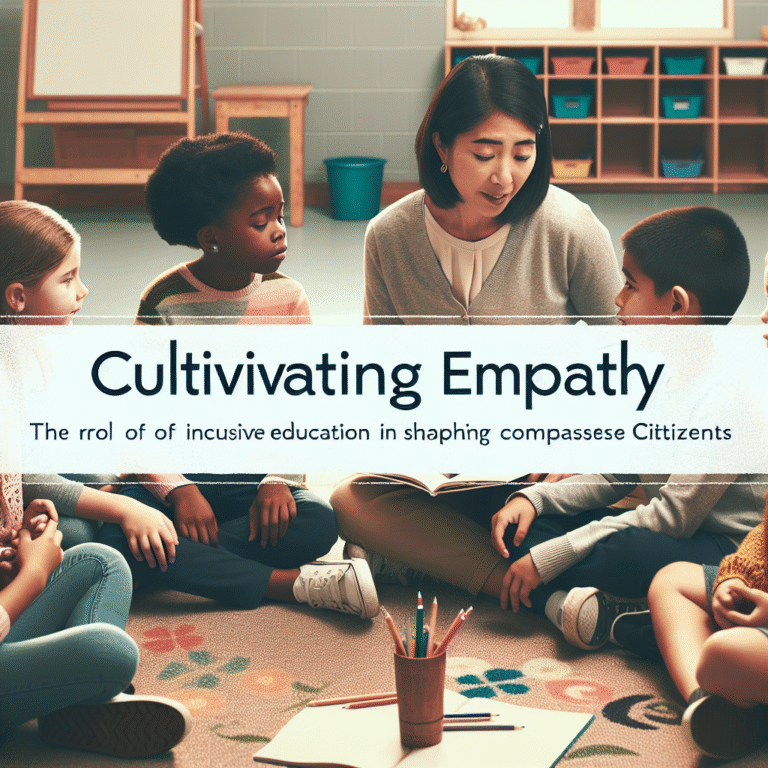
Introduction
Imagine a classroom where students are not just passive receivers of information but active seekers of knowledge. Beyond the Textbook: Engaging Minds with Inquiry-Based Learning Strategies is not merely an educational methodology; it’s a transformative approach that revitalizes the learning experience. Today’s educational landscape is shifting toward pragmatic learning, urging educators to rethink traditional teaching methods. The essence of inquiry-based learning (IBL) extends far beyond rote memorization, fostering critical thinking, creativity, and a genuine love for learning.
In this article, we will explore the powerful implications of inquiry-based learning, share compelling case studies that exemplify its effectiveness, and provide actionable strategies for educators seeking to engage students meaningfully. Join us on this journey to revolutionize education and discover how to engage minds beyond the textbook.
Understanding Inquiry-Based Learning
What is Inquiry-Based Learning?
Inquiry-Based Learning is a pedagogical strategy that encourages students to explore questions, problems, and scenarios rather than passively listening to lectures. At its core, IBL emphasizes the importance of curiosity and critical thinking, fostering an environment where inquiry drives the learning process.
The Historical Context
The roots of inquiry-based learning can be traced back to philosophies of notable thinkers such as John Dewey and Socrates, who emphasized the importance of experiential learning. These early proponents understood that knowledge is constructed through experience and dialogue, rather than through memorization alone.
The Core Principles of Inquiry-Based Learning
Student-Centered Learning: At the heart of inquiry-based learning lies a commitment to students’ interests and inquiries. Educators act as facilitators, guiding learners in their quest for knowledge.
Collaboration: IBL often involves group work and collaboration, encouraging students to discuss, share, and refine their ideas collectively.
Critical Thinking: Students are not just recipients of information; they are agents of their learning, expected to analyze, evaluate, and synthesize information.
- Flexibility: Inquiry-based learning allows for adaptability in teaching strategies, aligning with students’ needs, questions, and interests.
Engaging Minds: The Benefits of IBL
Engaging minds through inquiry-based learning has numerous advantages:
Enhances Retention: Inquiry-based techniques lead to deeper understanding, meaning that students are more likely to remember what they’ve learned.
Develops Problem-Solving Skills: As students tackle real-world questions, they build essential skills that are applicable beyond the classroom.
- Fosters Independence: Students become self-directed learners, developing autonomy and responsibility in their educational journeys.
Real-World Applications: Case Studies in Inquiry-Based Learning
Case Study 1: High School Science Curriculum
Context: A high school in California integrated inquiry-based approaches into their science curriculum.
The Approach: Instead of traditional experiments, students were asked to formulate their scientific questions. They designed experiments to test their hypotheses, thus leading to a more in-depth understanding of scientific principles.
Outcome: The students exhibited higher engagement levels and improved academic performance. Many expressed a renewed interest in pursuing careers in science, demonstrating that inquiry-based strategies can cultivate passion and promote lifelong learning.
Analysis: This case study illustrates how inquiry-based learning can transform a standard curriculum into an engaging and relevant experience, enabling students to take ownership of their education.
Case Study 2: Elementary School History Class
Context: An elementary school in New York shifted from textbook-focused history lessons to inquiry-driven projects.
The Approach: Students were tasked with researching a historical event of their choice, collaborating in groups to create presentations that incorporated multiple perspectives and narratives.
Outcome: The students developed strong communication skills and a broader understanding of history, with a significant improvement in their ability to analyze historical events critically. This shift resulted in a marked increase in student engagement.
Analysis: This case reinforces the idea that inquiry-based strategies not only make history more tangible but also develop essential skills such as collaboration and critical analysis among young learners.
Case Study 3: University-Level Research Projects
Context: A local university implemented inquiry-based learning in graduate-level environmental studies.
The Approach: Students identified environmental issues relevant to their communities, formulated research questions, and executed their research projects with minimal supervision.
Outcome: The students produced significant research papers that contributed to local knowledge on environmental conservation, demonstrating the real-world applicability of their findings.
Analysis: This approach empowered students to play an active role in addressing societal challenges. It showcased how inquiry-based learning extends well beyond K-12 education, promoting critical thinking and real-world application in higher education.
Implementing Inquiry-Based Learning: Strategies for Educators
Creating an Inquiry-Based Culture
Developing an inquiry-based learning environment begins with fostering a culture that values questions. Educators can create structured classroom discussions where curiosity is celebrated.
Strategy: Implement questioning strategies, such as “think-pair-share” or “Socratic seminars,” to promote dialogue and engagement.
Encouraging Collaboration and Communication
Inquiry thrives in collaborative environments. Students should have opportunities to work together to explore their interests.
Strategy: Use group projects and peer feedback mechanisms to cultivate a sense of community among learners.
Integrating Technology
Technology offers endless opportunities for inquiry-based learning. Digital tools can facilitate research, collaboration, and presentation.
Strategy: Incorporate platforms such as Google Classroom, Padlet, or educational apps that encourage creativity and exploration.
Providing Support and Resources
Educators should guide students in their inquiry journeys, providing them with the necessary resources and support.
Strategy: Develop resource hubs (print and online) containing articles, videos, and tools related to curricula to aid students in their inquiries.
Building Assessment and Reflection into the Inquiry Process
Authentic Assessment Techniques
Traditional testing does not capture the depth of learning that inquiry-based methods facilitate. Authentic assessments can provide a more accurate picture of student learning.
Examples:
- Portfolios: Showcase learning progress over time.
- Peer Reviews: Allow students to evaluate each other’s work constructively.
Reflective Practices
Encourage students to engage in reflective practices to assess their learning processes.
Example: Journals or blogs where students can document their inquiries and reflect on their learning journey.
Conclusion
Beyond the Textbook: Engaging Minds with Inquiry-Based Learning Strategies is a powerful mantra for modern education. By prioritizing inquiry and fostering curiosity, educators can cultivate a classroom environment rich in exploration and engagement. Students become more than just recipients of knowledge; they evolve into critical thinkers and lifelong learners ready to tackle real-world problems.
As we strive to prepare students for an ever-changing future, embracing inquiry-based learning is essential. The educational landscape continues to evolve, and inquiry-based strategies are there to guide us. Dare to step beyond the textbook and embrace a future where education is not only informative but transformative.
FAQs
1. What are the key components of inquiry-based learning?
Key components include student-centered learning, collaboration, critical thinking, and adaptability to student interests.
2. How does inquiry-based learning differ from traditional learning?
Inquiry-based learning emphasizes active searching and critical thinking, while traditional learning typically focuses on rote memorization and passive reception of information.
3. Is inquiry-based learning suitable for all age groups?
Yes, inquiry-based learning strategies can be adapted for various age groups, from elementary through higher education.
4. How do I create an inquiry-based learning environment in my classroom?
You can foster inquiry by encouraging questions, promoting collaboration, integrating technology, and providing ample resources for exploration.
5. What assessments work best for inquiry-based learning?
Authentic assessments such as portfolios, projects, and peer reviews provide a more comprehensive evaluation of a student’s learning journey.
By adopting and implementing these strategies, educators can genuinely transcend the traditional classroom dynamic, paving the way for a better, more enriching educational experience that extends well beyond the confines of a textbook. Beyond the Textbook: Engaging Minds with Inquiry-Based Learning Strategies is not just an educational trend; it is a fundamental shift in how we conceive learning.

















